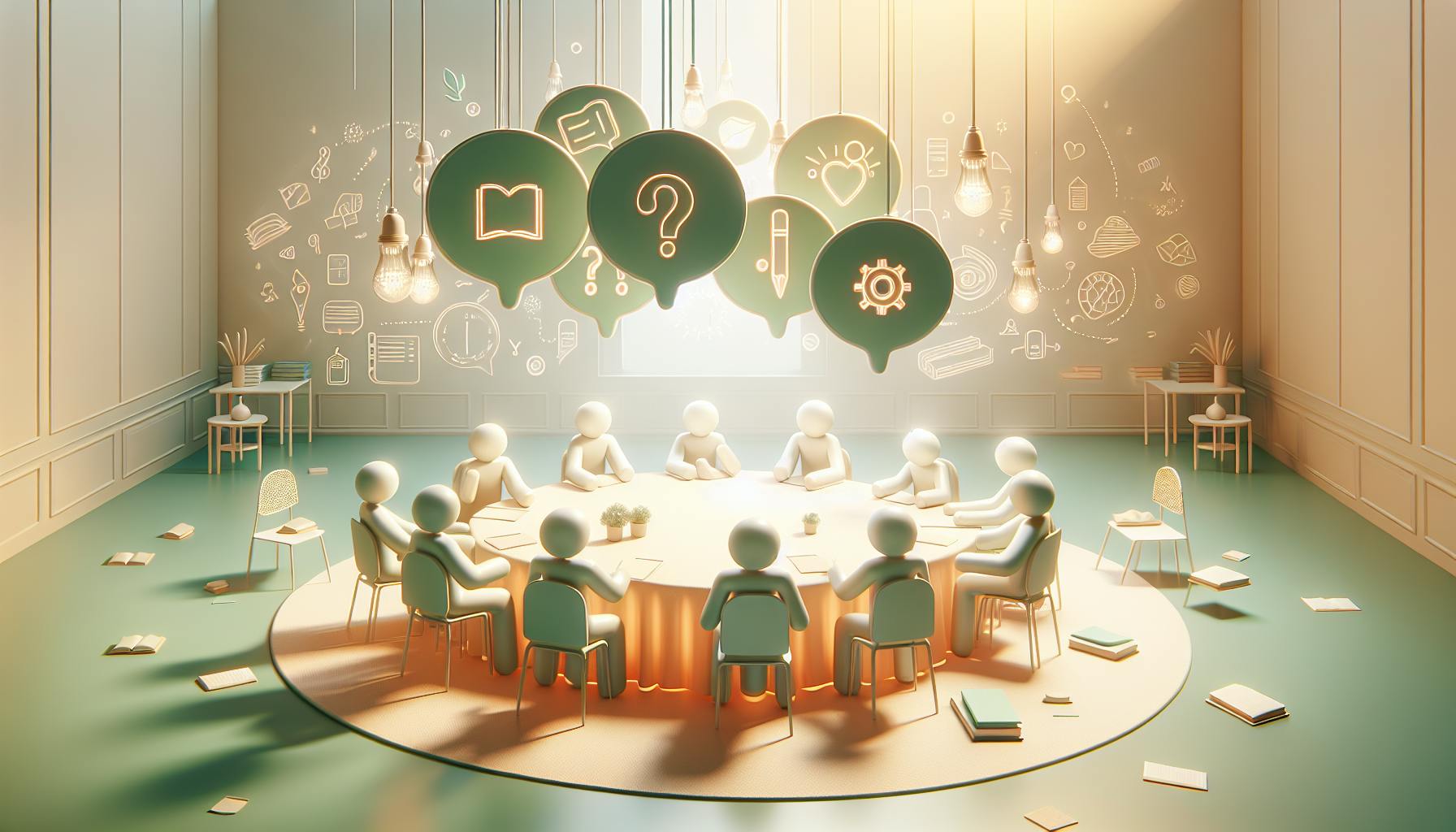Educators would agree that nurturing creativity and innovation in students is vital for their development.
Implementing maker spaces in schools can help achieve this by providing hands-on learning environments where students can design, experiment, and create.
This article will explore what maker spaces are, the benefits they offer students, and provide a blueprint for schools looking to launch their own, complete with real-world examples and tips for developing engaging curriculum and activities.
Introduction to Maker Spaces in Educational Environments
Maker spaces are creative environments equipped with high-tech and low-tech tools that enable students to design, experiment, build, and invent. By providing access to technologies like 3D printers, robotics kits, crafting supplies, electronics, and more, maker spaces cultivate collaboration, critical thinking, and hands-on learning. As schools aim to nurture 21st-century skills in students, implementing maker spaces is becoming an impactful strategy. This section will explore the maker movement in education and outline the benefits maker spaces offer students.
Exploring the Maker Movement in Education
The maker movement emphasizes learning through creating. Maker spaces originated from the idea of providing easily accessible tools and technologies to spark innovation. In recent years, schools have adopted the maker concept by creating dedicated maker spaces. These areas allow students to ideate, design, and produce creations using various materials and digital fabrication technologies.
From robot-building competitions to jewelry designing workshops, maker spaces enable endless possibilities to engage students in STEAM learning. They transform learning from theoretical to practical, empowering students to apply classroom concepts in building unique projects. Maker activities also enable peer learning as students collaborate, provide feedback, and help each other troubleshoot problems.
Overall, maker spaces align with the hands-on, personalized learning approaches gaining prominence in K-12 education. The experiential learning opportunities they provide are invaluable for schools aiming to develop critical thinkers and lifelong learners.
The Advantages of Maker Spaces for Students
Research shows maker spaces provide manifold benefits ranging from improving problem-solving abilities to promoting creative confidence. The hands-on learning experiences enhance student engagement, motivation, and interest in STEM topics.
Specifically, maker spaces help students:
- Apply theoretical concepts by ideating and developing maker projects
- Improve design thinking and problem-solving skills through iterative prototyping
- Enhance technological literacy and awareness of real-world applications
- Strengthen peer collaboration, communication and interpersonal skills
- Cultivate resourcefulness, grit and growth mindset
- Spark interest in STEAM career pathways
By facilitating hands-on learning and access to emerging technologies like 3D printing, maker spaces create more inclusive, dynamic learning for today’s students. The creative confidence and future-ready skills developed in maker spaces empower students to become innovative leaders and conscious citizens.
How are schools implementing Makerspaces?
Makerspaces have become increasingly popular in schools in recent years. Schools are implementing makerspaces in a few different ways:
Creating Dedicated Makerspace Areas
Some schools are converting empty classrooms or spaces into dedicated makerspace areas. These spaces are specially equipped with maker technologies like 3D printers, laser cutters, robotics kits, etc. Teachers can sign up to use the space for specific projects or makerspace time can be built into the schedule. Having a dedicated area allows for better organization and storage of maker equipment.
Building Makerspaces into Libraries
Other schools are integrating makerspaces right into their libraries. This allows students to access making tools alongside books, computers and other resources. Space and equipment needs to be carefully planned but it ties in well with the inquiry-based learning libraries strive for. Some schools hire special librarian-makerspace teachers to oversee projects.
Equipping Classrooms
Rather than a separate space, some teachers incorporate makerspaces supplies and tech right in their general education classrooms. This provides flexibility though can make storage and organization more difficult. Teacher training on leading maker activities is key. Moving maker carts between rooms helps bring key tech where needed.
With creative planning and effort, makerspaces can take shape in schools in ways that best fit needs and resources. Dedicated spaces allow for specialized development while classroom and libraries provide easier access and flexible options.
What would a classroom need to have a makerspace?
Here are some key things a classroom would need to have an effective makerspace:
- Basic art supplies like cardboard, construction paper, markers, crayons, scissors, glue, etc. These allow students to be creative and make simple projects.
- Craft materials such as felt, pipe cleaners, cotton balls, pom poms, googly eyes, etc. These open up more possibilities for students to build and experiment.
- Building supplies like Lego bricks, wooden blocks, popsicle sticks, straws, clay, etc. These help students construct prototypes and models.
- Technology resources like computers, tablets, 3D printers, robotics kits, programmable devices, etc. These allow students to learn coding, electronics, and other tech skills.
- A flexible layout with movable tables, whiteboard walls, and storage space to set up project areas. This enables multiple students to work on projects simultaneously.
- A collaborative culture focused on creativity, critical thinking, communication and not just the final product. This encourages students to learn from failures.
The key is having an assortment of open-ended supplies for students to tinker with. The makerspace environment is centered around the 4Cs - encouraging students to think Creatively, Critically, and Collaboratively while Communicating ideas.
What is a maker space for primary school?
A maker space in a primary school provides students with hands-on opportunities for creating, building, tinkering, and exploring a variety of materials. It's an area filled with tools and supplies where students can design, prototype, and make projects based on their own interests and curiosity.
Some key aspects of a primary school maker space include:
- Open-ended materials like craft supplies, building sets, circuits, robots, etc. that spark creativity
- Tools like hammers, wrenches, pliers, scissors, glue guns, tape, that enable building
- Technology like 3D printers, laser cutters, coding software that facilitate digital making
- A flexible layout with tables, storage, movable parts to allow reconfiguration
The teacher acts as a guide, allowing students to learn through experimentation at their own pace. Maker projects align to lessons in science, math, art and beyond. The hands-on nature builds problem-solving, collaboration, design thinking and other vital skills. Ultimately, it gives young minds an engaging space to create, explore and make their ideas tangible.
sbb-itb-bb2be89
What are the objectives of maker space?
The goal of a Makerspace is to empower students to see themselves as inventors, builders and creators. A Makerspace allows learning new skills through trial and error, experiencing failure of an initial idea, the exploration of possible alternatives and then problem solving to improve on the idea.
Some key objectives of implementing a Makerspace in schools are:
- Encourage creativity and critical thinking skills
- Teach students to turn ideas into tangible products
- Allow experimentation through building prototypes and models
- Develop skills like collaboration, problem-solving, and communication
- Provide hands-on learning opportunities with real-world applications
- Inspire an interest in STEM fields and careers
- Promote an entrepreneurial mindset of creation over consumption
By providing the space, tools, and support for students to design, build, break, and recreate projects based on their own interests and curiosities, a school Makerspace can facilitate rich learning experiences that drive engagement. With some initial investment in Makerspace supplies and lesson plans tailored for K-12 students, educators can bring the benefits of this innovative learning model into their school community.
Blueprint for Launching a School Makerspace
Makerspaces provide hands-on learning opportunities that tap into students' creativity and problem-solving abilities. As interest grows around STEM education, many schools are looking to bring makerspaces onto their campuses. Use this blueprint to launch your own successful school makerspace.
Crafting the Vision: Maker Space Ideas for Schools
Defining the vision and purpose of your makerspace is crucial for aligning activities to curriculum goals. Consider makerspace ideas such as:
- Elementary school - Focus on tinkering and experimentation through arts, crafts, and basic design challenges. Maker space ideas include sculpture, circuits, animation, coding games.
- Middle school - Expand to more complex projects like robotics, filmmaking, app coding, 3D modeling and printing. Allow students to identify real-world problems to solve.
- High school - Offer high-tech equipment for product prototyping, programming and electronics. Let students take the lead on group passion projects.
No matter the approach, emphasize imagination, critical thinking and hands-on problem solving. Tie challenges to core subjects like math, science and technology.
Navigating Space and Resource Allocation
Repurposing existing space is the most budget-friendly option for housing your makerspace. Consider converting a computer lab, library, classroom or even hallway space into a vibrant maker space. Maximize flexibility with mobile workstations and storage to allow for reconfigurations.
For a dedicated room, look for spaces with ample power outlets, lighting, ventilation and WiFi capacity. Seek proximity to complementary learning areas like labs, woodshops or art rooms for easy cross-disciplinary projects.
Sourcing Makerspace Supplies and Equipment
Stock your space with a deliberate balance of high-tech machines and everyday craft supplies. Prioritize versatile materials usable across projects and age groups.
Essentials: craft tools (hammers, pliers, saws), art supplies, building kits (LEGO, K'Nex etc.), programmable robots (Ozobots, drones), microcontrollers (Makey Makey, littleBits)
Nice to Have: 3D printers, vinyl cutters, drones, VR headsets, woodworking tools, electronics kits
Tap into library, PTA and community contacts for equipment donations. Seek grants and corporate sponsorships for larger budget items. Start small by adding new gear as excitement and usage grow.
With intentional planning and flexible implementations, schools can reap immense rewards from makerspace programs. This blueprint covers key steps - now it's time to make your vision a hands-on reality!
Makerspace Curriculum Development and Integration
Integrating a makerspace into a school's curriculum requires thoughtful planning and design. Here are some strategies for developing engaging makerspace lessons, activities, and projects tailored for middle school students.
Designing Makerspace Lessons for Middle School
When designing makerspace lessons for middle schoolers, it's important to tap into their innate curiosity and emerging independence. Consider activities that:
- Allow them to tinker and experiment with hands-on projects
- Encourage creativity, innovation, and design thinking
- Incorporate building, programming, electronics, robotics, etc
- Support multiple learning styles like visual, kinesthetic, verbal
- Promote collaboration through group challenges
- Solve real-world problems middle schoolers care about
Lessons should strike a balance between structure and open-ended exploration. Provide enough guidance so students don't feel lost, but leave room for them to make choices and learn by doing.
Interdisciplinary Projects and Challenges
The makerspace is the perfect place for cross-curricular learning. Try having students:
- Design structures to withstand "natural disasters" incorporating physics, engineering, environmental science
- Build programmable robots that interact with their environment covering computer science, biology, design
- Create educational games that teach concepts from mathematics, history, English etc.
- Construct musical instruments and compose songs integrating physics, design, and music theory
These types of projects allow students to apply knowledge from multiple disciplines while bringing abstract concepts to life through hands-on learning.
Innovative Learning Experiences: Middle School Makerspace Ideas
Here are some makerspace project concepts specifically tailored to inspire middle school-aged students:
- Design and race CO2-powered dragsters while modifying designs to reduce drag and friction
- Upcycle everyday materials into useful inventions like pencil holders, phone amplifiers, or wearable tech
- Build basic circuits and code programs to get LEDs blinking in patterns and play tunes
- Print 3D keychains, chess pieces, pencil toppers, or figures from popular video games
- Use Makey Makeys to turn fruits and playdough into musical keyboards and game controllers
- Program Ozobots, Spheros, or drones to navigate obstacle courses and mazes
- Create stop-motion animation shorts and green screen videos about topics students are passionate about
The key is crafting lessons that empower students to experiment, get hands-on with technology, solve meaningful problems, and explore their own interests through creation and design. With thoughtful implementation, school makerspaces unlock innovation and ignite passion for STEAM learning.
Real-World Makerspace Success Stories
Inspiring Makerspace Examples from Various Schools
Makerspaces are transforming education by providing hands-on, project-based learning opportunities for students. Here are some real-world examples of successful school makerspaces:
Middle School Library Makerspace Focused on Community Involvement
The Hillview Middle School library makerspace engaged the local community by hosting "family build nights". Students led their parents through laser-cutting projects, robotics activities, and more. This strengthened inter-generational bonds while promoting technical skills. The program expanded into summer makerspace camps, allowing more students to acquire valuable 21st-century abilities.
High School Fab Lab Driving Entrepreneurship
At Eastside High School, the Fab Lab makerspace taught entrepreneurship through real-world product design/development projects. Students used makerspace tools like 3D printers and CNC machines to construct inventions they could license or sell. One student team created an ergonomic handle that reduces strain for garden tools. This type of open-ended, entrepreneurial education motivates students and prepares them for business/innovation careers.
Elementary School Makerspace Used for Individualized Education
Sunnydale Elementary customized their makerspace to support personalized learning plans, especially for neurodiverse students. With tools like laser cutters, robotics kits, textiles equipment and digital media workstations, teachers could tailor projects to accommodate different learning abilities/styles. Students with special needs particularly benefited, gaining confidence through successfully completing hands-on makerspace modules adapted to their skills.
Analyzing the Impact: Surveys and Academic Metrics
To demonstrate the value of school makerspaces, librarians and administrators should gather usage metrics and assess impact on learning outcomes. Useful evaluation techniques include:
Student/Teacher Surveys: Distribute questionnaires asking students and teachers about changes in enthusiasm, confidence, collaboration skills, problem-solving abilities, and other makerspace benefits. Track ratings over time.
Skills Assessment Rubrics: Develop project evaluation rubrics that measure communication, creativity, critical thinking, and other makerspace skills. Compare students' rubric scores to baseline.
Academic Performance Analysis: Correlate school makerspace usage with course grades, standardized test scores, and other key performance indicators. Highlight positive trends.
Library Circulation Statistics: Assess circulation of STEM books/media before and after introducing makerspace. Increased interest can demonstrate impact.
By regularly conducting evaluations through surveys, rubrics and circulation analysis, school librarians can highlight the tangible learning impacts of makerspaces. This data is invaluable for promoting continued funding and support.
Cultivating a Culture of Innovation: The Makerspace Wrap-Up
Makerspaces in schools provide students with opportunities to tinker, create, explore, and bring their ideas to life. As this journey comes to an end, it's worth reflecting on key learnings and looking ahead at the future of making in education.
Reflections on the Maker Space Journey in Schools
Implementing a makerspace requires commitment at all levels. Here are some critical factors for success:
- Secure administrative support: Pitch your vision to leadership and secure funding for space, tools, materials, and staffing. Document impacts to showcase value.
- Design an adaptable layout: Optimize workflow and accessibility. Mobility of tools, storage solutions, and modular workstations allow flexibility.
- Start small, then expand: Launch with basic, cost-effective tools (arts supplies, electronics kits, 3D pens, etc.) and add advanced equipment as needed.
- Scaffold projects: Guide students as needed, but let them learn through tinkering. Break problems down step-by-step and provide just-in-time support.
- Celebrate successes: Showcase creations through fairs, assemblies, newsletters, and award ceremonies. Highlighting student work keeps excitement brewing.
With proper cultivation, makerspaces become vibrant hubs of creativity, critical thinking, and innovation in schools. Takeaways from successful implementations pave the path forward.
Charting Future Pathways: The Evolving Role of Makerspaces
As education continues to emphasize real-world skills for emerging tech-centric landscapes, makerspaces will play an integral role in schools. We anticipate growth in the following directions:
- VR/AR integration: Blending digital and physical making with immersive technologies.
- Advanced equipment: Laser cutters, CNC machines, and other commercial-grade tools.
- Interdisciplinary projects: Cross-pollination with diverse subjects (art, engineering, business, etc.)
- University partnerships: Collegiate collaborations on project-based initiatives.
- Entrepreneur programs: Guiding students to develop marketable products.
By continuously evolving and staying ahead of the curve, makerspaces will further unlock creativity and ingenuity in future generations. The culture of innovation takes shape one idea at a time.


